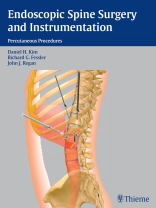Minimally invasive surgery has made tremendous strides in recent years, with exciting advances in instrumentation and techniques rapidly changing the scope of these procedures. Here is the first text to comprehensively review the newest developments shaping the field today and in the future. You will find in-depth guidelines and approaches for performing cervical, thoracic and lumbar spine surgery; percutaneous procedures; and state-of-the-art image-guided and robotic surgery. Enhanced by nearly 650 high-quality images, this text is an essential resource for all specialists who want to fully understand these operative methods and integrate them into their practice.
Key features:
- Technique-oriented text that also provides the fundamentals for a complete understanding of the minimally invasive approach
- Organized into seven clear, well-defined sections for quick reference
- Key discussions of minimally invasive interbody fusion; thoracic discectomy, trauma stabilization, lumbar decompression, tumor resection, and much more!
For all neurosurgeons, orthopedic surgeons, and spinal surgeons, this is an invaluable and practical tool as well as an educational resource. You will not find a more thorough and current review of minimally invasive spinal techniques written by the leading surgeons in the country. Upgrade and expand your practice with this key information!
Inhoudsopgave
<p><strong>Section 1 Minimally Invasive Spine Surgery</strong><br>Chapter 1 Historical Background of Minimally Invasive Spine Surgery<br>Chapter 2 Endoscopic Surgical Equipment<br>Chapter 3 Anesthetic Considerations and Operating Room Setup for Minimally Invasive Endoscopic Spine Surgery<br><strong>Section 2 Cervical Spine</strong><br>Chapter 4 Endoscopic-Assisted Transoral Odontoidectomy<br>Chapter 5 Anterior Endoscopic Cervical Microdiskectomy<br>Chapter 6 Percutaneous Endoscopic Cervical Diskectomy and Stabilization<br>Chapter 7 Posterior Cervical Microendoscopic Diskectomy and Laminoforaminotomy<br>Chapter 8 Microscopic Cervical Laminectomy and Laminoplasty<br>Chapter 9 Endoscopic Posterior Fixation of the Cervical Spine<br><strong>Section 3 Thoracic Spine</strong><br>Chapter 10 Thoracoscopic Diskectomy<br>Chapter 11 Posterolateral Endoscopic Thoracic Diskectomy<br>Chapter 12 Endoscopic Transpedicular Thoracic Diskectomy<br>Chapter 13 Thoracoscopic Management of Spinal Tumors<br>Chapter 14 Minimally Invasive Instrumentation, Correction, and Fusion of Primary Thoracic and Thoracolumbar Scoliosis<br>Chapter 15 Thoracoscopic Approach for a Deformity with Frontier Instrumentation<br>Chapter 16 Combined Prone Position Thoracoscopic Anterior Release and Posterior Instrumentation for Deformity Surgery<br>Chapter 17 Thoracoscopic Decompression and Fixation (MACS-TL)<br><strong>Section 4 Lumbar Spine</strong><br>Chapter 18 Posterolateral Selective Endoscopic Diskectomy: The YESS Technique<br>Chapter 19 Endoscopic Lumbar Foraminoplasty<br>Chapter 20 Lumbar Microendoscopic Laminoforaminotomy and Diskectomy<br>Chapter 21 Paraspinal Endoscopic Laminectomy and Diskectomy<br>Chapter 22 Endoscopic Pedicle Screw Instrumentation and Decompression<br>Chapter 23 Endoscopic/Percutaneous Lumbar Pedicle Screw Fixation<br>Chapter 24 Minimally Invasive Transforaminal Lumbar Interbody Fusion<br>Chapter 25 Percutaneous Translaminar Facet Screw Fixation<br>Chapter 26 Laparoscopic Fusion of the Lumbosacral Spine<br>Chapter 27 Endoscopic Lateral Transpsoas Lumbar Spine Fusion<br>Chapter 28 Gasless Endoscopic ALIF: The BERG Approach<br><strong>Section 5 Percutaneous Procedures</strong><br>Chapter 29 Percutaneous Vertebroplasty For Painful Vertebral Body Compression Fractures<br>Chapter 30 Kyphoplasty<br>Chapter 31 Intradiskal Electrothermal Therapy<br>Chapter 32 Nucleoplasty<br><strong>Section 6 Image-Guided Endoscopic Spine Surgery</strong><br>Chapter 33 Fluoroscopic Image-Guided Spine Surgery<br>Chapter 34 Image-Guided Endoscopic and Minimally Invasive Spine Surgery<br><strong>Section 7 Robotic Spine Surgery</strong><br>Chapter 35 Robotic Endoscopic Spine Surgery</p>












